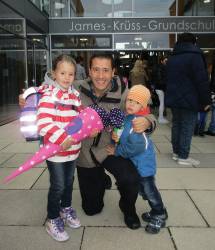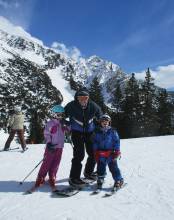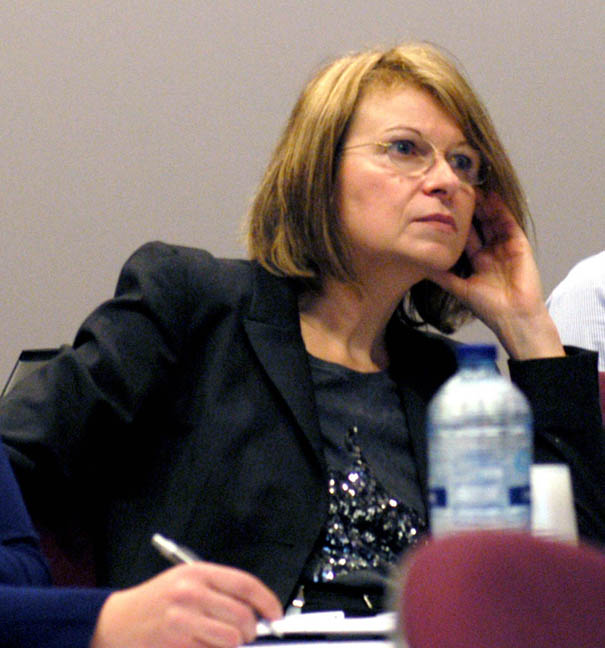 Belabbas with his children, Laila and Lunis.
Belabbas with his children, Laila and Lunis.Boubeker Belabbas’ Compass Points
Boubeker Belabbas, an expert in aerospace mechanics and safety-critical GNSS applications, grew up in Bordeaux, a city of wine, and works in Munich, a city of beer. But he started out in the land of mint tea: a small village in the north of Algeria in the region called Kabylia.
Boubeker Belabbas’ Compass Points
Boubeker Belabbas, an expert in aerospace mechanics and safety-critical GNSS applications, grew up in Bordeaux, a city of wine, and works in Munich, a city of beer. But he started out in the land of mint tea: a small village in the north of Algeria in the region called Kabylia.
His family is Kabyle, one of the largest Berber-speaking ethnic groups in Africa whose homeland is located about a hundred miles east of Algiers. His father, Boudjema Belabbas, was a mason and Fazia, his mother, was a housewife.
Belabbas recalls spending a lot of time with his grandparents as a small child in Kabylia.
“I took my first steps with them,” he says. “We lived in a village where there was no electricity. And I still remember the day when workers came to install the first electrical cables. I can even remember the smell of tar covering the wooden poles.”
Belabbas’ father worked in France during the 1970s, and subsequently he and many other Kabyle immigrants were given the opportunity to bring their families to live with them. It was a turning point in young Boubeker’s life. He was six when the family moved to Bordeaux, and that’s where he grew up. “I saw so many things for the first time,” he recalls, “aircraft, trains, buses. . . . My mom used to say that I was incredibly curious about everything. I was always asking questions, especially ‘How does this work?’”
His family lived on the second floor of a two-storey building, with an interior courtyard where he used to play with his younger brother Kamal and older sister, Zaina, an important source of inspiration to Belabbas.
Since his parents grew up during the Algerian war and didn’t have access to any form of public education, they wanted Belabbas to have what they had missed when they were young, and encouraged him to do well in school. But Zaina was really the one motivated him to excel.
“Her ability to learn was tremendous,” he says. “She was already a girl of nine when she started school in France, and yet she still managed to become one of the best in her class! She served as an example to me but also to my younger brothers and sisters.”
Two years younger than Belabbas, Kamal is both a friend and a rival, Belabbas says.
“He helps to keep me at the top of my game, and he belongs, with Zaina and myself, to those who were born on the other side of the Mediterranean Sea. We are the ones who were between two cultures.” Zaina now works as a quality manager for a food laboratories cooperative in the Toulouse area, and Kamal is a financial advisor with a French bank.
Belabbas also has three newer siblings born in France, a brother and two sisters, Karim, Hakima and Melaize “They are French natives, but all of us, we were always made to remember our roots in Kabylia.”
Belabbas says living in a large family can have its drawbacks, particularly if you are growing up in modest circumstances. “We had to share everything, and we learned some very important lessons, like knowing the value of money, exchanging with others and building team spirit, taking responsibility for one’s younger brothers and sisters. Leadership and diplomacy were among the important lessons we learned.”
But for escape, Belabbas recommends judo, which he took up at the age of seven.
“Judo and school were the best combination for me,” he says. “The one was like an escape, when I didn’t feel good in the other.”
The combination worked. Belabbas made his way up the academic ladder, eventually achieving a master of science degree in aerospace mechanics at the Ecole Nationale Supérieure de l’Aéronautique et de l’Espace (ISAE SUPAERO), one of the most selective Grandes Écoles in France and the first dedicated aerospace engineering school in the world.
A Professional Trajectory
Early on, Belabbas was convinced that the main driver of space business would be the applications enabled by satellites.
His hands-on work in the field of GNSS started in 2001, with an internship for his master’s thesis at Thales Alenia Space, formerly Alcatel Space Industry, in Toulouse, where he discovered satellite navigation.
“I was immediately hooked,” he recalls. “Compared to satellite communications, an area that had already reached a level of maturity but was lacking in terms of breakthroughs, I saw an incredible potential for development in satellite navigation.” Since then, Belabbas says that GNSS has continuously provided outstanding results and has confirmed his decision to work in the field.
For his thesis, Belabbas worked on Europe’s GNSS satellite-based augmentation system (SBAS), the European Geostationary Navigation Overlay Service (EGNOS) System Test Bed (ESTB), more specifically on cycle slip characterization at the ESTB ground stations. After completing his master’s degree in 2001, Belabbas started work as a research engineer on the characterization of GNSS error sources at the German Aerospace Center (DLR), just outside of Munich.
In 2005 he decided to concentrate on GNSS integrity. “I was very concerned about safety-critical GNSS applications, where positioning needs to be not only accurate but also reliable.” In 2006 he started to build the DLR Navigation Integrity Group, that he has officially led since 2011, at that time managing seven engineers.
It is now the largest group in the Navigation Department at DLR’s Institute of Communications and Navigation, with 12 researchers and a plan to expand to 14 in 2016.
But that’s getting ahead of the story. . . .
In 2006, with the support of DLR, he got the opportunity to visit the Stanford GPS Lab to work with Per Enge, a pioneer in GNSS-based aviation and maritime applications, and his team for a month.
“It convinced me that the potential of GNSS is unlimited, and I really discovered my passion,” he says. “Today, GNSS is deployed in so many applications, including smart phones. There are so many opportunities and new ideas about how to improve its usage, how to adapt our engineering activity to serve new applications, how to bring robust navigation safety solutions from an aircraft into our pocket.”
When he came back from Stanford, Belabbas started to work on air transport navigation, looking for ways to improve the integrity of satellite navigation to meet stringent aviation requirements. “I was amazed by the level of reliability that can be achieved by signals whose power is much lower than the noise floor,” he says.
First, he studied receiver autonomous integrity monitoring (RAIM), then moved to SBAS integrity concepts, and then ground-based augmentation systems (GBAS). At the same time, he joined several international projects dealing with navigation for aviation. The most important of these was the European Commission–funded project “Anastasia.”
Led by Thales Avionics, the Anastasia project carried out research on future technologies and system architectures for air transport navigation, with a view to facilitating the introduction of satellite-based technologies into aircraft operations in both navigation and communications.
Within Anastasia, Belabbas was responsible for a navigation studies work package. He managed a number of project components, among them: antenna design; signal acquisition and tracking, and position, velocity and time (PVT) algorithms, including tight coupling with microelectromechanical systems (MEMS) inertial sensors.”
In another EC-funded project called “Gagarin,” also led by Thales Avionics, Belabbas was responsible for the development of the RAIM algorithm for a dual-constellation Galileo/GLONASS receiver. The new RAIM algorithms were tested in actual flight.
Belabbas also led an internal DLR project dealing with GBAS instrument landing category III (CAT III), where the team achieved a worldwide first: a full CAT III GBAS Approach Service Type-D (GAST-D) flight validation in August 2011.
This success led the team to further activities addressing dual-frequency, multi-constellation (DFMC) ground-based augmentation systems, aimed at increasing the availability of GBAS worldwide, including in the equatorial regions and other places with high ionospheric activity. They also explored the possibility of using GBAS to enable automatic taxiing from runway to gate and from gate to runway.
Having carried out a number of important works demonstrating the high level of GNSS integrity achievable through the use of augmentation systems, Belabbas turned his attention to tackling the continuity problem — ensuring the availability of positioning and navigation capability during GNSS outages.
“Using independent ground ranging sources with inertial sensor hybridization,” he explains, “we worked to fill in the gaps when GNSS is lost due to strong jammers.”
Belabbas is heavily involved in another DLR internal project “Unmanned Flight Operations” (UFO), which is aimed at developing GNSS-based technologies for unmanned aeronautical systems (UAS). Another part of the project is the development of a high-altitude platform and the corresponding navigation system for both the control of the platform and for allowing the platform to be used as a pseudo-ranging source.
Finally, a project that Belabbas holds particularly dear, and which resulted in a European patent, was aimed at developing an inertial sensor–based track-change detector for trains.
“I am particularly proud of this work because it responds to a safety issue in train navigation — that of avoiding collision,” he says. “Recent events like the train accident in Spain in 2015 or the head-on collision of two trains in Bavaria in 2016 show that safety should be at the center of every system we are suggesting.
“I want to tune my career towards this fundamental engineering objective, to answer safety issues in my field of research, to implement these innovative safety solutions and to contribute to saving lives.”
Always On His Mind
Through it all, Belabbas has stayed in close touch with his parents and siblings. He and his brother Kamal, for so long the inseparable ones, chose their own paths after finishing school. “He was more interested in wineries and the wine-making process,” Belabbas says, “which is somehow weird for a Muslim, but then avoiding wine when you live in Bordeaux is almost impossible.”
Second brother Karim studied IT and works in a financial department of a large bank, while Hakima studied science and Melaize studied literature and works at the Library of the Sorbonne University in Paris.
And Belabbas now has his own family in his adopted home country of Germany. He met his German wife Nicole in 2002. They have a six-year-old daughter, Laila, and a four-year-old son, Lunis — both born in Munich.
In spite of his many professional responsibilities, Belabbas says staying close to his children is non-negotiable.
“It is hard for me to be on business trip for more than a week,” he says. “I miss them so much. They seem to understand when I have to be away, and we try to video chat every day. Once, though, in 2014, I had to be in the United States on business for four weeks and I realized then that it was just too much. Laila was crying on the phone and I really felt guilty and irresponsible for spending so much time so far away from my children.”
From then on, Belabbas says, he decided to limit his business trips to a maximum of one week. His family means that much to him.
“The most important is that they are happy in their lives,” he says. “I hope both of my children will follow an engineering career, but I don’t want to impose anything on them.
“It is surprising to see how clever they are and how adaptive they are in different situations,” he observes. “Sometimes I think I learn more from them than they learn from me.
Where the Heart Is
Belabbas says he was expecting to feel somewhat at home when he moved from France to Germany in 2001. “After all,” he says, “we are all Europeans, but, in fact, I was surprised to discover such a different way of living, such different points of interest. And I realized there are even differences between Bavaria and the rest of Germany.”
Among the changes, he points out, “I left a city of wine, in Bordeaux, to embrace a city of beer, in Munich!”
Once again, as he had done as a young boy, Belabbas found himself living in a new country, learning a new language, and adapting to a new culture.
When he returns to Bordeaux to see his parents, “he notices how strongly the cultures differ and how strongly his new life in Germany had influenced him. “I have started speaking French with a German accent!” he said, “And when I’m looking for a word, it comes to me first in German!”
Belabbas enjoys trekking in the Alps during the summer and skiing in the winter, taking his children on visits to such places as the Ammersee (Lake Ammer), or the zoo in Munich.
Home and office, career and family, Boubeker Belabbas has successfully managed to interweave the varied strands of his life, with a story that spans cultures, countries, and continents, while always feeling at home in the world.





